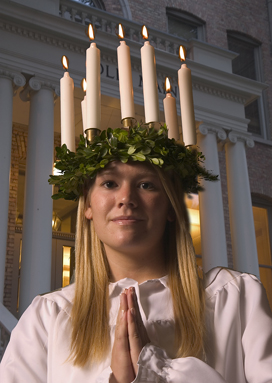This Sunday my family (from Finland) celebrates "Santa Lucia" in Belgium and it is the first year that we will not be there to enjoy the big family reunion. As we become nostalgic during the holiday season we decided to continue the tradition.
We spent the weekend decorating our house because Christmas is approaching. We found a real tree! We really needed to go to the other side of the world to find such a beautiful dense fluffy tree.
 |
| Our real x-mas tree in Oz |
 |
| A hint to my Danish side |
What is Santa Lucia for Nordic European countries?
"Santa Lucia" (13th o December) is the winter-light festival, a celebration of light during the darkest days of the year in Nordic countries. Lux, luci means "light". The horror story is from the 5th century in Sicily where a Christian virgin refused to marry a man who removed her eyes or denounced her and she got her eyes removed. Since then she is the saint patron of blind people.
In our traditional celebration, a young woman of the family wears a white dress with a red ruban carrying a crown of candles. She is usually followed by the other children of the family.
 |
| Picture from Internet |
And a good celebration means FOOD! :-)
 |
| Warm Cinnamon Bullar from Ikea |
And last but not least : The Glögg which is popular around Christmas, it is the perfect cold weather drink, warming the body and soul from the inside out. A funny site explains what it is in details: Glögg
Our family recipe is brilliant but I think it is the first time ever that it has been prepared on a BBQ when the thermometer outside shows more than 25°C.
 |
| It's Stroooong! |
It's difficult to beleive that we are Summer here...




Pourquoi appelons-nous Glögg ce délicieux breuvage à base d'alcool, d'eau, de sucre, de fruits et d'épices alors que partout sur le web il nous est raconté qu'il s'agit de vin chaud, certe épicé ?
ReplyDeleteSalut Samuel,
ReplyDeleteQuelle bonne question! Je pense que c'est une évolution et une question d'alcool abondant et peu cher... Que qqn me corrige si je me trompe.
Selon les informations sur le net, ça remonte au temps de Romains qui épiçaient le vin chaud en pensant qu'il y avait des bienfaits thérapeutiques.(Ouai-ouai je me soigne!!!)
Tous les Glöggs ont une base de vin ou de porto (blanc ou rouge) ce qui est du vin recuit.
En Allemagne (Gluhwein) et dans la majorité de la Suède, ils le font à base de vin. En 1609, le roi de Suède était un amateur de vin chaud Allemand et l'a appelé "glödgad vin" = vin chaud ardent, ce qui est devenu "Glögg". (Plus facile à dire surtout après qqs verres...)
La recette de Finlande toujours à base de Porto est une version pour vrais Vikings influencée par les Russes et leur amour pour la Vodka ou aquavit. J'imagine aussi que c'est l'alcool le moins cher et le plus courant alors pourquoi diluer du vin avec de l'eau alors qu'on peut le faire avec de la Vodka? En Irlande ils le font avec du Whisky (Pourquoi pas?!) et aux Etats-Unis avec du Brandy (= vin distillé).
Notre recette familiale (qui date de la guerre???) fabrique son propre alcool encore moins cher en diluant de l'alcool à 90% avec de l'eau jusqu'à obtention du degré voulu et puis on ajoute le Porto, sucre et épices... Chaque famille a sa recette, comme pour celle de la bolo. :-)